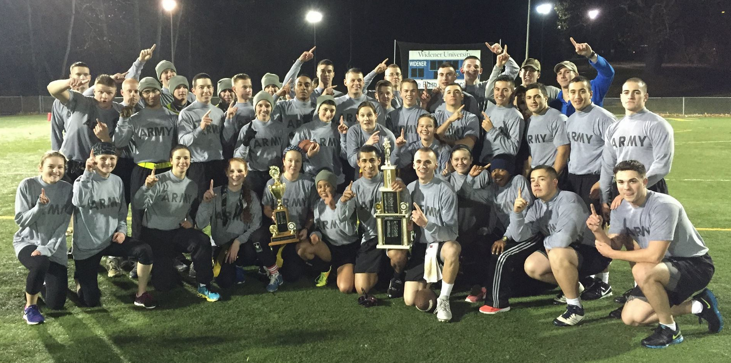Villanova army ROTC: under-funded but overachieving
April 22, 2015

Villanova fosters a rich history of commissioning officers into the military. On campus, there are more than 100 Navy Midshipmen, more than 30 Army Cadets and more than a half dozen Air Force Airmen. It is a well-known fact that the Navy has done a lot to contribute to Villanova’s success as a reputable academic institution, including once saving Villanova from financial failure and commissioning many famous Alumni. The Villanova NROTC program is without a doubt a point of pride for our school. In light of all of this, many Villanovans do not realize that Villanova has an Army ROTC program as well.
Villanova Army ROTC is one component of the Dauntless Battalion, which includes local schools such as Widener, Penn State Abington and West Chester Universities. Although Villanova has only one full time Army Officer stationed on campus, the Army ROTC program is entirely campus-based. All training activities, from physical training to classes and labs, happen here at the University.
Cadet David Schulz, a sophomore in the Villanova School of Business, decided to follow in his father’s footsteps by attending Villanova and joining ROTC. Cadet Schulz decided to pave his own path by joining the Army program instead of the Navy like his father. It was a decision that Cadet Schulz credits to his desire, “to be on the ground, in the dirt and in the grime instead of cooped up on a boat somewhere.” Despite the many differences between the Army and the Navy, the programs still do have a lot in common, including physical training or “PT,” military science class, and a military science lab. Cadet Michael Killian, a junior math major who will be living off campus next year with a Navy Midshipmen, explained his thoughts on Navy and Army’s differences. “Some people like their peanut butter crunchy and some people like their peanut butter creamy, but at the end of the day it is still peanut butter.”
One of the key differences between the Army and Navy programs on Villanova’s campus is the disparity of resources. Villanova’s Army ROTC equivalent of John Barry Hall is the old Villanova Emergency Medical Service building on southwest campus, right next to Simpson Hall. This small shack built in the side of a hill has only two offices, a single sex bathroom, a classroom, and two storage rooms. The “Hooch,” as Cadets call it, is far from glamorous, but it accomplishes the tasks required of running our program on campus. However, this difference in amenities has not stopped high achieving Villanova Cadets from being successful. The current senior class of Villanova Army Cadets contains eight commissionees of the roughly 5,000 cadets that will be commissioned into the National Guard, Army Reserve and Active Duty Army nationwide. Of these 5,000 Cadets, around 80 educational delays are granted each year for Cadets looking to pursue graduate degrees in Medicine, Law or Theology. This coming year, three of Villanova’s Army ROTC Cadets have been granted this opportunity. They will be attending medical school with financial assistance from the Army for tuition.
To reach these levels of success, Cadets live intense lives, with PT on Monday, Wednesday, and Friday mornings from 6:30 to 7:30. If this same Cadet has not been scoring high enough on his Army Physical Fitness Test, he will also have to attend remedial PT on Tuesday and Thursday. If a Cadet is meeting his fitness standards and wants to further challenge his fitness he may participate in Ranger Challenge practice. Ranger Challenge serves as the Army’s version of a varsity sport. Teams from across the region compete against each other in obstacles, such as a rope bridge across a river, a Humvee push and a 10-kilometer march with 40-pound weighted backpacks. On Tuesday afternoons, Cadets meet for a weekly class where they discuss military tactics and leadership. On Thursday afternoons, Cadets attend a weekly Military Science lab where they take the infantry style tactics that they have been learning in the classroom and apply them to a hands-on experience on Tolentine Field. Most Army ROTC Cadets have weekends off. However, once a semester there is a weekend of field training exercises that consist of taking all of the tactics reviewed in lab and applying these skills in the woods at Fort Dix, N.J. This past fall, Villanova’s Army ROTC worked with a series of programs from the area in order to organize its first annual Norwegian Foot March. Cadets and National Guard Soldiers from Pennsylvania and Delaware participated in a 30-kilometer foot march with 25 pounds of canned food in their bag. At the completion of the March all 3,200 cans and more than $1,300 in money were donated to a local Veterans home. Along with volunteer opportunities on weekends and a day of service in the spring, Villanova Cadets take numerous opportunities to give back to Veterans and the community around them.
While walking around Villanova’s Campus, if you see someone in a ROTC uniform that is not tan or white, he is probably an Army Cadet. No, they will not be living on a submarine one day, because the Army does not have submarines. If you do have any questions for them, feel free to ask, and if you like your peanut butter a little bit crunchier than the rest, ask about joining. You won’t be disappointed.


